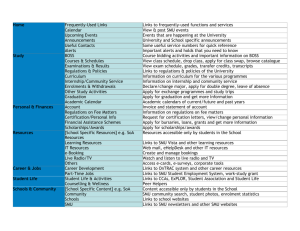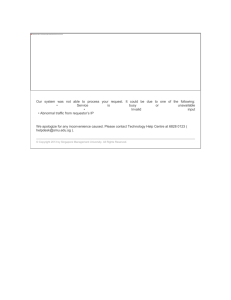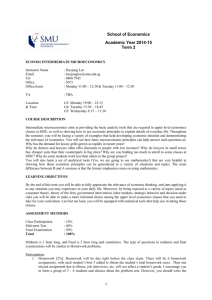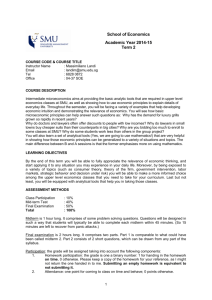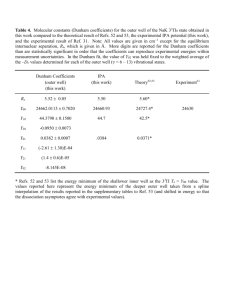mobile computing and databases
advertisement
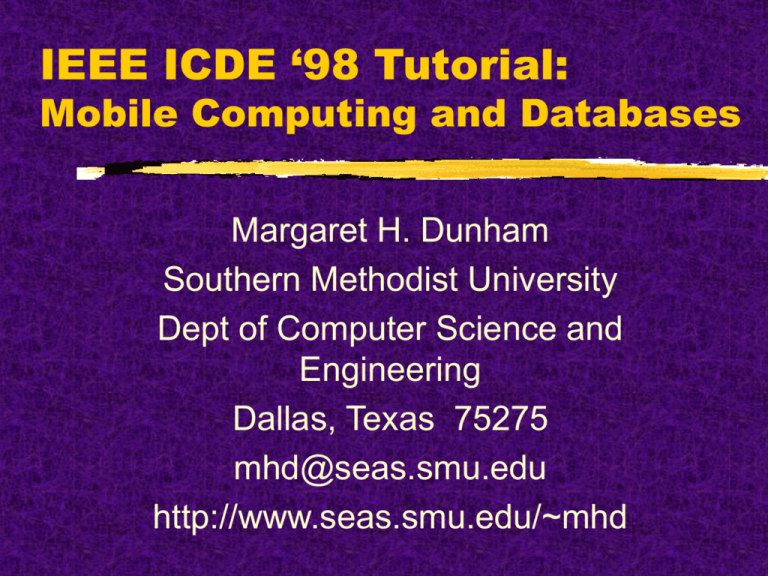
IEEE ICDE ‘98 Tutorial:
Mobile Computing and Databases
Margaret H. Dunham
Southern Methodist University
Dept of Computer Science and
Engineering
Dallas, Texas 75275
mhd@seas.smu.edu
http://www.seas.smu.edu/~mhd
Outline
Introduction & Data Management Issues
Query Processing
Caching
Data Broadcasting
Transaction Processing
Agents
Projects & Products
Conclusion
2/24/98
ICDE/SMU - Dunham
2
Mobile Computing Architecture
2/24/98
ICDE/SMU - Dunham
3
Terminology
Fixed Network (FN)
Base Station (BS) (Mobile Support Station (MSS))
Fixed Hosts (FH)
Cell - Area covered by BS (1-2 miles)
Handoff - Changing BS by intercell move
Mobile Host (MH) (Mobile Unit (MU))
2/24/98
ICDE/SMU - Dunham
4
Wireless Networks
Cellular
High Cost
Scalability Issue
Limited Bandwidth: 10 Kbps
Wireless LAN
Traditional LANs with wireless interface
Low Cost
Limited range: 10-100 meters
Bandwidth: 10Mbps
NCR Wavelan,ICDE/SMU
Motorola
ALTAIR
2/24/98
- Dunham
5
Wireless Networks (cont’d)
Satellite Services
Wide Coverage
Very Expensive
Low Bandwidth: 1-2Mbps
Paging Networks
Wide Coverage
Sky Tel, Motorola
Slow: (Ethernet: 10Mbps; FDDI or switched
Ethernet: 100Mbps; ATM: 155Mbps)
2/24/98
ICDE/SMU - Dunham
6
Handoff
Changing BS due to
movement between cells
State information
transferred
Current handoffs in
cellular phones may
take up to a few seconds with
breaks in conversation of 100-300 ms.
Soft - Temporarily connected to two BSs
Hard - Only connected to one BS
2/24/98
ICDE/SMU - Dunham
7
Location Management
Tracking mobile user
User associated with home
A
location server (Home Agent)
A
May augment by searching
in local
S
area first
M
May augment with user profiles
Mobile IP [11,14]
h
f
Triangle Routing
Route Optimization
Location Control (Routing Agent)
2/24/98
ICDE/SMU - Dunham
S
Ah
Af
M
8
Location Management (cont’d)
Active Badge (Cambridge,[2])
Track employees and route telephone calls
Unique code emitted every 15 seconds
Sensors placed in offices and corridors
Location Information Replications
No HLR
Hierarchy of Location Servers
Each server maintains information about its subtree
2/24/98
ICDE/SMU - Dunham
9
Mobile Applications
Information Services (Yellow Pages)
Law Enforcement and Medical Emergencies
Sales and Mobile Offices
Weather, Traffic, Sports, Entertainment
Trucking
Cellular Subscribers in the United States:
90,000 in 1984;4.4 million in 1990;
13 million in 1994
Handheld computer market will grow to $1.77
billion by 2002
2/24/98
ICDE/SMU - Dunham
10
Technology Push
Internet: ftp, telnet, email, http,html
Advancing Wireless Communication
Technologies
Laptop, Notebook, and Palmtop Computers
2/24/98
ICDE/SMU - Dunham
11
Classification of Mobile Database
Systems
2/24/98
ICDE/SMU - Dunham
12
Data Management Issues
Speed of wireless link
Scalability
Mobility
Location dependent data; Location specific
queries
Limited by battery power
Disconnection (Voluntary, Involuntary)
Replication/Caching
Handoff
2/24/98
ICDE/SMU - Dunham
13
Insurance Example
2/24/98
ICDE/SMU - Dunham
14
Medical Example
911 Call
Ambulance arrives/departs
Closest hospital
Access patient records
Send vital signs
Update patient records
Page hospital personnel
Order medical supplies
2/24/98
ICDE/SMU - Dunham
15
MC/DB Research
Transaction Processing
Caching - Replication
Broadcast Disks
Agents
Mobility
Location Dependent Data
Recovery
ACID (?)
2/24/98
ICDE/SMU - Dunham
16
Outline
Introduction & Data Management Issues
Query Processing
Location Dependent Queries and Data
New Query Types
Query Optimization
Caching
Data Broadcasting
Transaction Processing
Agents
Projects & Products
Conclusion
2/24/98
ICDE/SMU - Dunham
17
Location Dependent Data
Value of data depends on location
Temporal Replication - One consistent value at
one time
Spatial Replication - Multiple different correct
data values at one time
Temporal Consistency - All data objects satisfy a
given set of integrity constraints.
Spatial Consistency - Consistency constraints
satisfied within Data Region.
SMU/University of Missouri at Kansas City, [17]
2/24/98
ICDE/SMU - Dunham
18
Location Dependent Queries
Result depends on location
Different from traditional distributed goal of
location independence
Ex: Yellow Pages, Directions, Map
Predicates based on location: “Find the
cheapest hotel in Dallas.”
Location constraints: “Find the nearest hotel (to
me).”
2/24/98
ICDE/SMU - Dunham
19
Similarity to Spatial Queries
Spatial Data: Data associated with space
occupied by object.
Types of spatial queries: contains, contained in,
intersects, neighboring, east of, etc.
Spatial data structures
Spatial operators
Spatial selects and joins
PSQL - extend SQL, [18,20]
2/24/98
ICDE/SMU - Dunham
20
Differences from Spatial Queries
Client is actually moving
Location of client may be
Spatial data is dynamic
part of the query itself
May depend on direction of movement
Data may not directly contain location
information
Includes temporal features as well
2/24/98
ICDE/SMU - Dunham
21
Querying Moving Objects
Moving Objects Spatio-Temporal (MOST) data
model
Dynamic Attributes - Change over time
Queries over temporal history:
Instantaneous - Ex: “Find all restaurants I’ll reach in the
next half hour. ”
Continuous - Ex: “Find all restaurants within 5 miles.” The
answer continuously changes as the MU moves.
Persistent - Ex: “Find the cars that travel greater than 10
miles in the next half hour.”
Future Temporal Logic (FTL) language
University of Illinois, [20]
2/24/98
ICDE/SMU - Dunham
22
Query Optimization
How best to satisfy the information request
made by the client?
Different Cost Factors: I/O, network
Different Access Options: cache, FN, broadcast
Dynamic and Adaptable - environment changes
Alternative plans include deciding (based on
state of MH and environment) whether to
access in the cache at the MH, to request a
mobile transaction, or to obtain from a broadcast
disk.
2/24/98
ICDE/SMU - Dunham
23
Outline
Introduction & Data Management Issues
Query Processing
Caching
Overview
Types
Research
Data Broadcasting
Transaction Processing
Agents
Projects & Products
2/24/98
ICDE/SMU - Dunham
Conclusion
24
Caching
Placing data at MU. Usually on disk.
Faster to access from MU than from DBMS in
fixed network.
Facilitates disconnected operation.
Adaptive to connection mode.
Not just another replica
Pull based
Most work on files not databases
2/24/98
ICDE/SMU - Dunham
25
Caching Functions
Data fetching
Granularity (Page, file, table, semantic)
Replacement
Coherency
Callback - Servers send invalidation messages to
clients.
Detection - Clients send queries to servers to.
Updating during disconnect
Data integration when reconnected
2/24/98
ICDE/SMU - Dunham
26
Connectivity and File Systems
Table 3.2 from [15]
2/24/98
ICDE/SMU - Dunham
27
MU Replica Control Protocols
Traditional Replication Protocol problems:
May hinder mobility
Quorum Consensus: Can’t get quorum if
disconnected; Avoid using MU replicas to make up
quorum
Location information not always readily available
Primary Copy: Should not be stored at MU
First class/Second class replicas
2/24/98
ICDE/SMU - Dunham
28
Checkpointing
Table 3.4 from [15]
2/24/98
ICDE/SMU - Dunham
29
Prefetching vs.. Hoarding
Both prefetch data in anticipation of future use.
Prefetching
Objective is to improve performance (throughput or
response time).
Cache miss not catastrophic.
Hoarding
Objective is to fetch all needed data into MU cache
prior to disconnect. Thus the goal is to facilitate
disconnected operation.
Cache miss is catastrophic.
OK to overfetch
2/24/98
ICDE/SMU - Dunham
30
Hoarding/Spying
Listening to and recording file accesses
Performed during a snapshot interval
May be combined with user profiles.
Results limited to the snapshot.
2/24/98
ICDE/SMU - Dunham
31
Disconnected Issues
Table 3.1 from [15]
2/24/98
ICDE/SMU - Dunham
32
Coda
First project to demonstrate disconnected
operation.
Optimistic Locking
Granularity - sets of files.
Coherency - callbacks
Hoard Walking: Periodically (every 10 min)
evaluate contents of cache. Recalculate priorities.
On a callback break, object is purged, refetching
on demand or during next hoard walk.
Venus - cache manager at MU
2/24/98
ICDE/SMU - Dunham
33
Coda (cont’d)
Venus states:
hoarding,emulating,write
disconnected (earlier
reintegrating).
Cache misses during
disconnection are treated as
failures.
During disconnection, a log
(Change Modify Log) of
operations is created.
2/24/98
ICDE/SMU - Dunham
Hoarding
Write
Disconnected
Emulating
Adapted from Fig 2 in [34]
34
Coda (cont’d)
During integration, log applied. Conflicting updates
are determined and user assists in resolution
Timestamps at volume and object level used to
determine conflicts.
Trickle Reintegration used to asynchronously
propagate updates.
Hoard Profile - list of files and priorities.
Lowest priority objects chosen for replacement.
Weak Connectivity - low bandwidth, high latency,
high cost, or intermittent
CMU, [29,34]
2/24/98
ICDE/SMU - Dunham
35
Little Work
Disconnected AFS
Cache operations depends on type of
connection
Connected - Continuous; High bandwidth; Normal
operation
Partially Connected - Continuous; Dialup; Delayed
writes
Fetch Only - On demand; Cellular; Optimistic
replication
Disconnected - Fail if cache miss
2/24/98
ICDE/SMU - Dunham
36
Little Work (cont’d)
Caches 64KB chunks of files
Fetch only mode
Modifications sent back to primary file server
Conflicts stored separately and user notified
Michigan, [25,26]
2/24/98
ICDE/SMU - Dunham
37
Seer
Ficus
Uses semantic information to determine
contents of cache.
Semantic distance between files measured in
number of file accesses on average between
two files.
Access is defined as open-close.
Distance measure used to cluster files.
Fetching of a cluster based on user hints and
LRU information.
UCLA, [24,30]
2/24/98
ICDE/SMU - Dunham
38
Summary
Table 3.1 from [15]
2/24/98
ICDE/SMU - Dunham
39
Sleepers and Workaholics
Cache invalidation report
Periodically (synchronous) the server
broadcasts report of changed data.
MU waits for next report prior to answering
query.
Sleepers - frequently disconnected; cache
invalidation based on signatures.
Workaholics - rarely disconnected; periodic
broadcast of changes.
False Invalidation
MITL
and Rutgers,ICDE/SMU
[21] - Dunham
2/24/98
40
Transparent Analytic Spying
File Working Sets
Continually observe and
record (in a log) file access. At
hoard time, reference the log
to determine hoard.
Trees for a process are
created reflecting file access
pattern. One tree per program
execution is generated.
2/24/98
ICDE/SMU - Dunham
A
B
D
C
E
F
Access Tree
41
Transparent Analytic Spying (cont’d)
Hoard all files or only those in in the most recent
execution.
Tracing adds about 2% CPU overhead.
Average space for file log record is 100 bytes.
Implemented on Unix, NFS, Mach
Cache miss rate over wireless slightly higher
than on wired.
Prefetching overall reduced cache misses and
elapsed time
Columbia, [36]
2/24/98
ICDE/SMU - Dunham
42
Predictive File Caching
Analyze file access patterns in different environments:
Personal productivity, Programming, Commercial
Working Set Statistics: Mean working-set sizes small
(18MB per day)
Attention Shift Statistics: 0.6 per user per week
Conflict Statistics: Depends on environment
Conclusion:
Hoarding is possible due to small working set size
LRU caching insufficient
UCLA, [31]
2/24/98
ICDE/SMU - Dunham
43
Virtual Primary Copy
Mobile Primary Copy (MPC) at MU
Virtual Primary Copy (VPC) at BS
Global transactions access VPC
Consistency of VPC maintained by BS
BS monitors MU disconnect
Multilayered approach is transparent to other
sites
Monash, [23]
2/24/98
ICDE/SMU - Dunham
44
Roam
MC Replication System
MU Peer to Peer
communication allowed
Ward Model:
Ward: Grouping of replicas for
locations that frequently
communicate
Ward Set: Set of replicated data
stored in a ward.
Ward Master: Doorway into
ward. Maintains consistency
2/24/98 between wards.
ICDE/SMU - Dunham
45
Roam (cont’d)
Ward members are “close”
No “pre-motion” operations
Intra-ward synchronization easier than interward
Reconciliation- Synchronization process
Selective replication at file level
Scales well
UCLA, [33]
2/24/98
ICDE/SMU - Dunham
46
Semantic Cache
Caching granularity at a predicate level
SPJ query - Materialized view
Advantages: reduces network overhead,
reduces cache space
Disadvantages: Indexing, query trimming
Semantic Cache - C = {Si}
Semantic Segment - Si=<Sr,Sa,Sp,Sc>
SMU
2/24/98
ICDE/SMU - Dunham
47
Outline
Introduction & Data Management Issues
Query Processing
Caching
Data Broadcasting
Overview
Indexing
Research
Transaction Processing
Agents
Projects & Products
Conclusion
2/24/98
ICDE/SMU - Dunham
48
Data Broadcasting
Server continually broadcasts data to MUs.
Scalability: Cost does not depend on number of
users listening.
Mobile Unit may/may not have cache.
Facilitates data access during disconnected periods.
Allows location dependent data access.
No need to predict with 100% accuracy the future
data needs.
Broadcast based on probability of access.
Periodic broadcasting of all data.
2/24/98
ICDE/SMU - Dunham
49
Data Broadcasting (cont’d)
Classification:
Coverage - Everything, Subset
Content - Static, Dynamic
Indices - Index, Self Descriptive
Data Stream - Flat, Skewed, Multiple Disks
Client - Passive, Active
For uniform page access, flat disk has best
expected performance.
With skewed page access, nonflat disks are
better.
Push based.
2/24/98
ICDE/SMU - Dunham
50
Broadcast Disks
Simulate multiple
disks of varying
sizes and speeds.
Data of higher
interest on smaller
faster disks
Figure 4.1 from [15]
(broadcast more frequently).
Each “disk” contains data with similar access
behavior.
Combination of caching and broadcast disks.
2/24/98
ICDE/SMU - Dunham
51
Broadcast Disks (cont’d)
Don’t want to store hottest pages. They may be
broadcast frequently.
Store in cache if probability of access (P) is
greater than the frequency of broadcast (X).
Cost based page replacement.
Replace cache page with smallest P/X - PIX.
Too expensive to implement.
LIX - PIX approximation. Works well particularly
with noise.
Brown, MITL, Maryland, [37,38,39]
2/24/98
ICDE/SMU - Dunham
52
Air-Cache
Dynamic - Adapts to system workload.
Define temperature of data:
Vapor (Steamy) Hot - Accessed frequently
and broadcast.
Liquid Warm - Accessed often, not
broadcast, but kept in server’s main memory.
Frigid (Icy) Cold - Accessed infrequently and
stored on secondary storage.
2/24/98
ICDE/SMU - Dunham
53
Air-Cache (cont’d)
Three level memory hierarchy based on
temperature.
Sparks (access) to data can increase
temperature. No sparks, results in a reduction
of temperature.
Simulation results predict very good
performance.
Maryland, [43]
2/24/98
ICDE/SMU - Dunham
54
Adaptive Protocols
Dynamically modify broadcast contents.
Constant Broadcast Size (CBS) Server Protocol:
Limited size and periodic
Priority
Popularity Factor (PF)
Ignore Factore (IF)
Variable Broadcst Size (VBS) Server Protocol:
Aperiodic
All data above threshold PF included.
Arizona and UMKC, [40]
2/24/98
ICDE/SMU - Dunham
55
Outline
Introduction & Data Management Issues
Query Processing
Caching
Data Broadcasting
Transaction Processing
Overview
Transaction Model
Concurrency
Recovery
Research
Agents
Projects & Products
Conclusion
2/24/98
ICDE/SMU - Dunham
56
Mobile Transaction (MT)
Database transaction requested from a MU.
May execute in FN or MU
Issues
Disconnect/Handoff
Mobility
Location Dependent Data
Error Prone
MU Resources/ Power
Recovery/Restart
Management
2/24/98
ICDE/SMU - Dunham
57
MT Requirements
Keep autonomy of local DBMS
LLT
Interactive
Advanced transaction models
Nested
Multidatabase
Request from MU
Execute anywhere
Capture movement
ACID (?)
2/24/98
ICDE/SMU - Dunham
58
MT Approaches
No consensus on accepted approach
MU may not have primary copy of data [45]:
Transaction Proxy: MU does no transaction
processing
Read Only Transaction: MU only reads data
Weak Transaction: Read and update cached data;
Must synchronize updates with primary copy on FN.
MU may have primary copy of data
MU may access data on other MUs
First class and second class transactions
2/24/98
ICDE/SMU - Dunham
59
MT Recovery
Transaction, site, media, network failure - More
frequent than in wired network.
Different types of failures (partial)
Handoff
Voluntary disconnection
Battery problems
Lose computer??
Checkpoint data at MU to BS
Checkpoint at handoff
Database log plus transaction log
May
need compensating
transactions
2/24/98
ICDE/SMU - Dunham
60
Atomicity for MT
Weaken or provide different types of atomicity
May decompose transaction into
subtransactions
May require atomicity at lower than transaction
level
Atomic commitment difficult (expensive)
Global commit/Local Commit
2/24/98
ICDE/SMU - Dunham
61
Consistency for MT
Weakening isolation and atomicity may weaken
this as well.
May divide data into clusters with consistency
within clusters.
Reintegration of updates after reconnect may
cause many conflicts.
May use bounded inconsistency.
Impacted by location dependent data
2/24/98
ICDE/SMU - Dunham
62
Isolation for MT
May be too restrictive
Can’t always do at MU (disconnection)
Isolation at lower levels in transaction
Commitment at different levels of transaction
Cooperating transactions
2/24/98
ICDE/SMU - Dunham
63
Durability for MT
Durability for partial results
May want durability for parts of transactions.
Due to conflicts at reconnect, even durability of
subtransactions may not be guaranteed.
Local commit vs.. Global commit
2/24/98
ICDE/SMU - Dunham
64
MT Concurrency Control
Mobility of MUs
may increase
message traffic
for lock
management
MU failure may
leave some data
locked /unlocked
2/24/98
1) T1: Lock(Xa);
Read(Xa)
2) T1 moves to B
Server A
Cell A
Server B
Cell B
Xb
Yb
Xa
Ya
3) T1: Lock(Yb);
Read(Yb)
6) T1: Unlock(Yb);
Commit;
6) T1: Unlock(Xa);
Commit;
Fig 2 from [48]
ICDE/SMU - Dunham
Xc
Yc
Zc
Server C
Cell C
4) T1 moves to C
5) T1: Lock(Zc);
Write(Zc);
Unlock(Zc);
Commit
65
Revised Optimistic Locking
O2PL-MT
Read locks may be
executed at multiple
servers.
Read unlock can be
executed at any site
Benefit shown using
analytic model
Purdue, [48]
2/24/98
LOCK
HELD
W_INTEND R_LOCK W_LOCK
LOCK
REQUEST
W_Intend No
Yes
No
R_Lock
No
Yes
No
W_Lock
No
No
No
Figure 3 from [48]
ICDE/SMU - Dunham
66
Kangaroo Transaction (KT)
Built on top of global transactions
Captures data and movement behavior
DAA as BS - Maintains logging and transaction
status
Logging at BS
Flexible atomicity
Restart after disconnect
Management moves
2/24/98
ICDE/SMU - Dunham
67
Kangaroo Transaction (cont’d)
Local Transaction - Sequence of read and write
operations ending in commit or abort
Global Transaction - Sequence of global or local
transactions
Joey Transaction - Sequence of global and local
transactions ending in commit, abort, or split
Kangaroo Transaction - Sequence of one or
more Joeys with last one ending in commit or
abort. All earlier end in split
SMU, [47]
2/24/98
ICDE/SMU - Dunham
68
KT and Movement
2/24/98
ICDE/SMU - Dunham
69
Reporting and Co-Transactions
Mobile transaction is a special type of
multidatabase transactions.
GDMS exists at each base station.
Subtransactions of the mobile transaction will
commit or abort independently.
Atomic and non-compensatable transactions.
Reporting and co-transactions.
Pittsburgh, [46]
2/24/98
ICDE/SMU - Dunham
70
Clustering Model
Views mobile transaction as beginning on
mobile and nonmobile hosts.
Transaction migration
Transaction model is designed to maintain
consistency of the database.
Database is divided into clusters.
Data is divided into core and quasi copies.
Mobile transactions and operations are
decomposed into a set of weak and strict
transactions.
2/24/98
ICDE/SMU - Dunham
71
Clustering Model (cont’d)
Weak operations access only data in the same
cluster. Strict operations allowed database wide
access. Two copies of data can be maintained
(strict and weak).
Clusters defined based on location and user
profile.
Transaction Proxy: dual transaction of one
executed at mobile host which includes only the
updates.
Purdue, [51,52]
2/24/98
ICDE/SMU - Dunham
72
Mobile Transactions and
Ambulatory Care
Medical Personal Digital Assistant (MPDA)
Battlefield - Cache copy of soldiers’ medical
records in MPDA
Distributed Medical Database - EMT obtains
patient’s medical record and updates.
BSA (Base Station Agent) is responsible for
logging and recovery.
Recovery based on sagas with save-points.
Mailboxes used to save information.
Purdue, [49,50]
2/24/98
ICDE/SMU - Dunham
73
Semantics-Based Mobile
Transaction Processing
Views mobile transaction processing as a
concurrency and cache coherency problem.
A stationary database server dishes out the
fragments of an object on a request from a
Mobile Unit.
On completion of the transaction, the Mobile
Units return the fragments to the server.
These fragments are put together again by the
merge operation at the server.
Pittsburgh, [54]
2/24/98
ICDE/SMU - Dunham
74
Multidatabase Transaction
Processing Manager
Mobile transactions built on top of multidatabase
global transactions.
Timestamps used to enforce ordering
Allows voluntary disconnections.
MU part of MDS
Message Queuing Facility (MQF)
MU sends request to designated coordinating
node on FN.
Monash, [56]
2/24/98
ICDE/SMU - Dunham
75
PRO-MOTION
MC/Database Transaction Processing approach
Multiple transaction types
Controlled divergence
ACID
Update cache and later DB at FH
Compact - Compact Agent at MU, Mobility
Manager at BS, Compact Manager at Server
Pittsburgh, [55]
2/24/98
ICDE/SMU - Dunham
76
MT Research Limitations
Architectural Assumptions
No support for location dependent data
Few Implementations
2/24/98
ICDE/SMU - Dunham
77
MT Management Options
MU
BS
Combination
Fixed/Relocatable/Moving
Agent
2/24/98
ICDE/SMU - Dunham
78
Outline
Introduction & Data Management Issues
Query Processing
Caching
Data Broadcasting
Transaction Processing
Agents
Overview
Client-Agent-Server Model
Mobile Agent
Projects & Products
Conclusion
2/24/98
ICDE/SMU - Dunham
79
Agent
Application dispatched by and
working for the client.
Agent:
Solves disconnect problem
Solves slow bandwidth problem
Client
Client
Agent
Server
Server
Client-Agent-Server
Agent Classification:
Type - Client,Server,Application,User
Movement - Static, Relocatable, Migrating (Mobile)
Number - Single, Multiple, Clonable
2/24/98
ICDE/SMU - Dunham
80
Itinerant Agent (Mobile Agent)
Program dispatched from mobile unit that roams
through the fixed network to satisfy client’s data
request.
At a server the agent is sent to an Agent
Meeting Point (AMP) where desired server
functions are determined and requested.
Client, Migrating, Single
IBM, [58]
2/24/98
ICDE/SMU - Dunham
81
Migrating User Agent
User process that mimics MU.
Process migrates as user moves.
Client, Migrating, Single
Massachusetts, AT&T, [63]
2/24/98
ICDE/SMU - Dunham
82
Remote Programming
Language for communication required.
User and server communication without using
network.
Places - Meeting points for agents and servers
Agents - Application is set of agents. Agent is
either at a place or travelling between places.
Travel - Go instruction
Meetings - Agents communicating at a place.
General Magic Telescript, [59]
2/24/98
ICDE/SMU - Dunham
83
Concordia
User
Agent
Oracle
Server
Query
Agent
Collaboration
Query
Agent
Adapted from Fig 6 in [61]
ICDE/SMU - Dunham
Concordia
2/24/98
Concordia
Mitsubishi Electra ITA
Java Objects; JDBC
Collaborating Agents
Agent Server - FN
User Agent - MU to BS
Query Agents- BS to
Server
Collaborator - BS
Mitsubishi Electric ITA,
[60,61]
Notes
Server
84
Outline
Introduction & Data Management Issues
Query Processing
Caching
Data Broadcasting
Transaction Processing
Agents
Projects & Products
Conclusion
2/24/98
ICDE/SMU - Dunham
85
Some DB/MC Projects URLs
MobiDick - Monash Univ. (Australia);
http://www.ct.monash.edu.au/~mobidick
Mobisaic - Univ. of Washington;
http://www.cs.washington.edu/homes/voelker/mobisaic
Purdue; http://www.cs.purdue.edu/research/cse/mobile
SMU; http://www.seas.smu.edu/~mhd/mobile.html
MCC - Collaboration Managment Infrastructure;
http://www.mcc.com/projects/transaction
University of Ioanina; http://zeus.cs.uoi.gr/
Michigan - CITI;
http://www.citi.umich.edu/projects/mobile.html
UCLA - Ficus; http://ficus-www.cs.ucla.edu/ficus
2/24/98
ICDE/SMU - Dunham
Columbia; http://www.mcl.cs.columbia.edu
86
Rover
Figure 6.1 from [15]
2/24/98
ICDE/SMU - Dunham
87
Oracle Mobile Agent
Commercial Product
Application, Static,
Multiple
Message Manager - MU
Message Gateway - BS
Agent - FN (Server)
[67,69]
Message Manager
Gateway
Corporate
Network
Agent
Database Server
2/24/98
ICDE/SMU - Dunham
88
Sybase - SQL Anywhere
Designed for
Windows, (95, 3.x,
NT), OS/2, DOS
Limited memory
requirements
Full TP capabilities
Includes SQL Remote
Compatible with
Sybase SQL Server
[68]
2/24/98
ICDE/SMU - Dunham
Remote Database
SQL Anywhere standalone engine
Message agent
Consolidated Database
SQL Anywhere network server
Message agent
89
Sybase (cont’d) - SQL Remote
Two way replication based on
Consolidat
message passing.
ed
DB
Remote database are synchronized
with consolidated DB
Message Agent required at DB server
Replication of subscribed fragments
Remote Databases
Periodic changes sent from consolidated
DB to remote DBs
Updates from committed transactions at remote
submitted to consolidated database.
Conflicts:
Consolidated
is master; Triggers used. 90
2/24/98
ICDE/SMU - Dunham
Informix
I-Mobile 1.0 discontinued:
No replication
Three tier approach appropriate for long term, but in
the short term users wanted to be able to use
existing client-server applications (not rewrite).
Small DBMS server to run on mobile client
Only dial up needed for now
Informix Dynamic Server/Personal Edition
(IDS/PE) for Windows 95/NT. Mobiles and
desktop clients
[64,66]
2/24/98
ICDE/SMU - Dunham
91
Outline
Introduction & Data Management Issues
Query Processing
Caching
Data Broadcasting
Transaction Processing
Agents
Products
Conclusion
2/24/98
ICDE/SMU - Dunham
92
Future
Combine different approaches
Semantic caching
Query Optimization
Adaptive Data Broadcasting
Performance Benchmarks
Security
Location Dependent Queries
2/24/98
ICDE/SMU - Dunham
93
Acknowledgements and URL
Bibliographies
Earlier version of this tutorial presented at the 1996
Brazilian Database Symposium.
We particularly want to thank Evaggelia Pitoura for
providing several tables and figures from her recent
book [15].
Some slide information obtained from slides presented
at a database class at the University of Massachusetts,
http://www-ccs.cs.umass.edu/mobile.
Online bibliographies
http://www.seas.smu.edu/~mhd/mobile.html
http://www.ct.monash.edu.au/~mobidick
2/24/98
ICDE/SMU - Dunham
94
